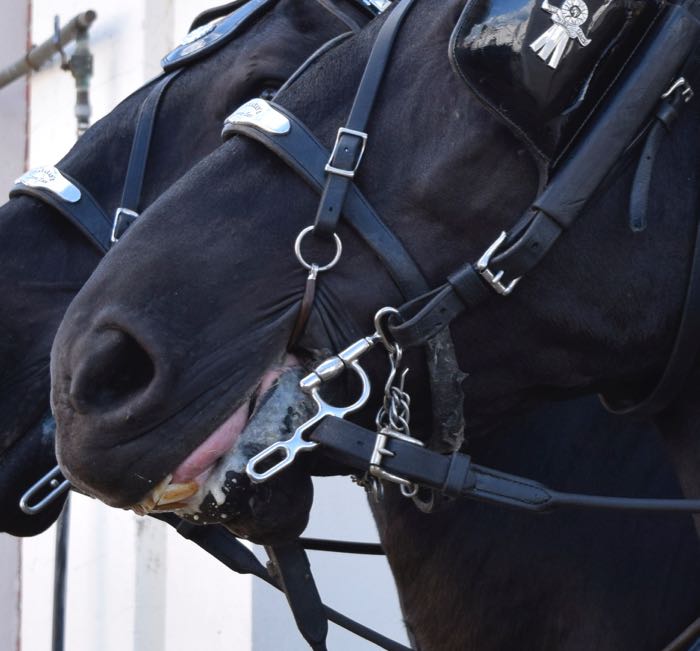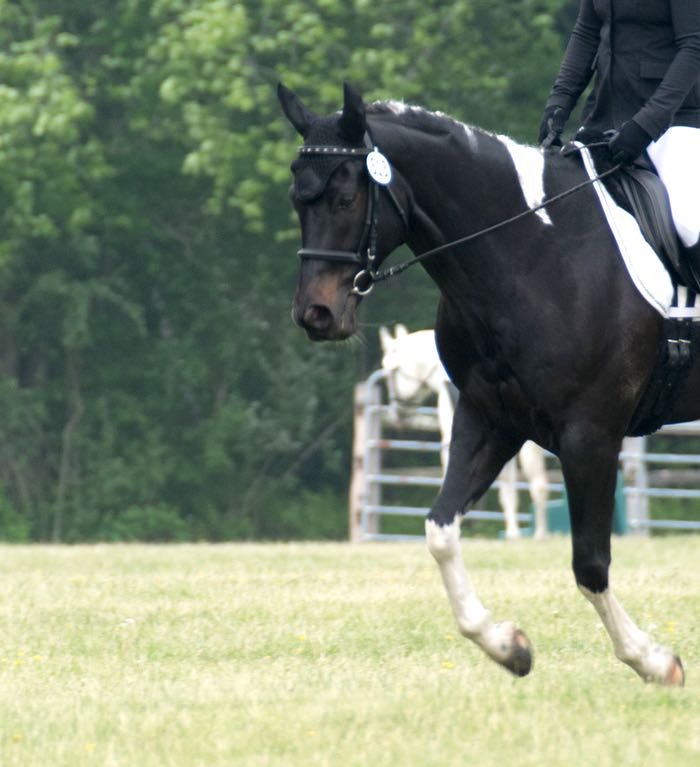The first thing that a new rider wants to learn, once they get up on this big, powerful animal, is how to stop it. (Well, there’s always one in a bunch who wants to gallop off, but not long after that they wish they’d learned where the brakes are!)

One of my students on her Friesian gelding
At a very basic level that’s what the reins and the bit are for. A horse’s jaw is lined with teeth, but there’s a short section, right near the corner of the lips, that is flat, bare gum. For a couple of thousand of years we’ve controlled our horses by placing something – a strap of leather or a metal bit – there. Pull back hard enough and the nose comes in, which slows the horse. Add rowels, arches, or plates to the bit and the action of the rein causes pain which the horse tries to avoid by stopping.

If you’re a knight in bulky armor and you can barely bend your fingers, you want that sort of control. People still use complex bits designed to get a quick response by causing pressure and pain. Take a look online at the selection. It doesn’t matter the discipline, whether it’s show jumping, western reining or backyard trail riding, bits are relied on for control. If the bit is severe, the horse will will try to avoid the pressure by opening their mouth, or raising their head. So, more gear is added, such as cavessons that crank the jaw closed, and martingales and pulley reins to hold the head down.

Once you recognize how severe this tack is, it can be hard to watch some riders try to control their horses. But it doesn’t have to be that way.

As an alternative, some people use bitless bridles. These vary, and although there’s no metal in the horse’s mouth, some are as harsh as those with bits – pressure is applied not on the bars of the jaw, but on the poll, under the chin and on the sensitive nose. A few types of bitless bridles are kind to the horse, and are useful for some riders and horses. Some people eschew the bridle altogether and ride “at liberty.” Some of those use a neck cord that looks harmless but can be as harsh as the worst bit. Some achieve liberty using aversive methods. A very few are using clicker training to ride without bridles.
Why Ride In A Bridle
In another post I’ll talk about using the bit for ring work and dressage, but this post is about stopping your horse on the trail. I ride on public land and roads, and often meet bicyclists, “enthusiastic” dogs, strollers pushed by toddlers, and even once someone on a unicycle! Tonk and I have crossed paths with wild turkeys, coyotes and snakes. Having him in a bridle with a mild bit is a safety thing. Just like I’d never walk my dog on the road without a leash, I’d never take my horse out without a way to control him immediately and safely in an emergency. Usually I ride on the buckle, but when there’s something that causes my horse a bit of anxiety, I take up contact and that calms him. The rein contact (and my body position and breathing) give him clear directions about how to handle the scary stuff. It’s not aversive and it’s not painful to him. Rather, it’s like taking someone’s hand to cross a street. Once in awhile, something so startling happens that he spooks. The other day, a bird flew up out of the hay field, not ten feet in front of us, and Tonk jumped five feet sideways. I happened to be take a photograph moments before:

As you can see, there’s plenty of open space here for a frightened horse to take off. There are woodchuck holes and other lurking dangers. Staying calmly on the trail is imperative.
In this instance, I gathered up the reins so that I had steady contact, sat quietly and steered him back onto the path. If Tonk didn’t have have confidence in my message that all was fine, he might have bolted. Although you can’t train your horse to not be scared of something as specific as a woodcock flying at his face, you can train him to trust you when you give the it’s okay message. We work on that trust on a daily basis when the stakes aren’t so high.
Teaching the Verbal “Ho” Cue
I’ve taught him that the word ho means stop. (Ho is no the pejorative term you might be familiar with. It’s a traditional equestrian word for halt. It’s brief, clear, and not like anything else said, which makes it the perfect cue.) I want Tonk to have a strong history of good things coming when he stops and stands quietly and so I trained this with positive reinforcement. To teach this, begin on a familiar path and ask for the ho only when the horse is relaxed. When I ride, my seat follows the motion of the horse’s swinging back, which encourages free, forward strides. When I want a horse to slow or stop, I stop following so that I’m no longer in sync with his movement. That subtle communication might be ignored by a horse that’s learned to be dull to their rider. But, do it consistently and clearly, and your horse will catch on that it’s the first thing that will happen before the request to halt. If you’ve been on the buckle, pick up a light contact and for a few strides follow the movement of the head and neck (the rider’s shoulder and elbow joints should be elastic so that the horse doesn’t feel any resistance as he moves.) When you want to stop, close those joints so that you’re no longer giving as the horse’s head bobs. This should be enough to halt the horse. If it isn’t, you can apply a stronger pressure, but that should be immediately released as soon as there’s a response. As the horse is stopping, the verbal cue “ho” is added. I train with a marker that lets the horse know the exact moment they’ve done the right thing, On the trail it’s a short verbal “Dee.” When Tonk hears that he understands that the behavior he just did (in this case stopping) is what I want and that he’ll be rewarded for it (I hand him a cookie.) This gives clarity to the training and progress is made quickly. Over time, you can fade the rein cue so that your horse stops on verbal cue only. The ability to stop a horse with just a word is useful on the trail, especially because I like to take photos from the saddle. Asking Tonk to stop while I’m using both hands to fiddle with my iPhone keeps me from dropping it on the ground! A verbal ho! is also useful when walking down the barn aisle and leading in from the pasture.
In order to train a reliable and immediate halt, the horse has to see the behavior as something very, very rewarding to do. A pat on the neck isn’t enough. Tonk gets cookies.
A few days ago Tonk and I were on a trail deep in the woods. We were relaxed and he was on the buckle. In a blink, his head went up and he tensed. I saw a flash of something up ahead. I said ho! and Tonk stopped. In my horse’s mind, this is a cue that something good will happen, so when the six-year old boy came running towards us, with a mother and sister trailing behind, Tonk was still sure that it would be a good thing. It was. I gave him a mint. Crisis averted.
Here’s a video of Tonk responding to a verbal cue. The reins are resting on his neck. No hands!


Let me just say this is amazing. Tonk is such a wonderful horse and obviously trusts and respects you. I can only imagine how many mints you have gone through with this training and every day with Tonk. Love this blog. Have a great day.
Thanks, Durbin! Although I do think that Tonk is the most wonderful horse, ever, this sort of training works for all horses, and can bring out the best in all of them.
Great post on the most important cue by far!! Also something to teach on the ground as part of the process of starting a horse under saddle, it amazes me that more people don’t use verbal cues to help transition from ground work to saddle.
One thing I try to impress upon students is the important of not using any other word that sounds similar as it introduces confusion. Many people new to horses instinctively use the word ‘No’ a lot and that dilutes the Ho (or Whoa) command.
Good point! Also, we want students to think in terms of what they DO want, not to be reactive, say “no” and try to suppress behavior.
Yes! Would love to see a future post on how to shape away those behaviors that can be dangerous when dealing with an animal of this size (e.g. ‘play’ biting behavior in young stallions). I’m new to the idea of clicker training but have been using positive reinforcement with horses forever. Always looking to learn more!
Think about using the clicker in those situations when you want to communicate that a very specific movement is what you want. Timing is everything! Have a dog? Practice on your pet first before trying this with a stallion 🙂
Great post. As I have said before always reminds me off the scene in Black Beauty where that horrible woman keeps asking for Beauty and Ginger’s heads to be made higher.
Jess has just made a large batch of your homemade treats for the horses, they certainly smell good enough to eat !!…:)
Yes, my family is always disappointed when they find out that the wonderful smell in my kitchen is for the horses 🙂
What an interesting, important, wonderful blog! Tonka looks like the horse I’ve dreamed of since childhood, well, more beautiful even. I never had a horse, just riding lessons eons ago – back when riding was all about imposing your will on the horse (or dog or, in most cases, on a child) with little consideration, respect, and patience. Blogs like yours should be required reading, ideally before people get on a horse for the first time. Thanks, I enjoy your posts greatly.
Thanks for your comment! It’s funny, when I was little my dream horse was a black horse with a white mane and tail. In my imagination, I named him Midnight Snow. It wasn’t until I brought Tonka home that I realized I had my dream horse.
“Midnight Snow” – a lovely dream name, and how wonderful that your heart horse turned out to be your dream horse (or vice-versa)!
P.S. I just listened a few times to Tonka grazing (“Hand Grazing Zen”)–and put a direct link to that post: it is The Perfect sound track for beaming myself, well, my imagination… from city life into a horse pasture for a few moments of zen… 🙂
Glad that the “zen” happens even via a computer 🙂